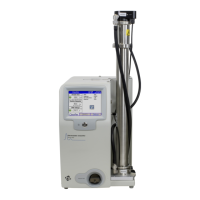B-16 Electrostatic Classifier Model 3082 and SMPS Spectrometer Model 3938
SMPS raw data (particle counts) are sampled in 0.02 seconds wide time
intervals i while the DMA voltage raises exponentially during a scan. All
further calculations to invert the data are made in 192 size bins j. These
size bins are logarithmically (or geometrically) evenly distributed between 1
nm and 1000 nm, which results in 64 size bins per size decade.
The first step in SMPS data inversion is to map particle counts from time
intervals i into size bins j as described by Equation B-10.
Equation B-10
Raw particle counts C in both the time intervals i and the size bins j can be
analyzed by importing measurement data – including raw data – sampled
with Model 3082 in SMPS mode into Aerosol Instrument Manager
software.
The raw particle counts C
j
accumulated in the size bins j are used to
calculate the particle number concentration dN
j
in each size bin at the inlet
of the SMPS Spectrometer. This calculation assumes that all counted
particles were singly charged. It uses the detection efficiency of the particle
detector η
det,j
for size bin j, an eventual dilution
in the flow equalizer or
due to DMA bypass flow, the fraction of singly charged particles f
1,j
for the
midpoint particle diameter D
m,j
of each size bin j, the Penetration P
j
of
particles with size D
m,j
through the SMPS system (to correct for diffusion
losses) , the flow rate Q
sensor
through the sensor of the particle detector and
the sampling time t
bin,j
associated with each size bin:
)D(Z
)D(Z)D(Z
PftQ
C
dN
j,m
j,upj,low
jjdet,j,1j,binsensor
j
j
Equation B-11
The sampling time t
bin,j
is the time interval, during which a size bin j can
receive particles during a scan; it is given by the DMA voltage
(Equation B-8), the electrical mobility for this voltage (Equation B-5), and
the upper and lower boundaries of a size bin j described in terms of
electrical mobility for singly charged particles (Equation B-4). The DMA
transfer with ΔZ(D
m,j
) is calculated using Equation B-6.
All higher weights or moments (surface area, volume, mass) of the number
concentration size distribution dN
j
are calculated per size bin j assuming
spherical particles with the geometric midpoint diameter D
m,j
of the size bin.

